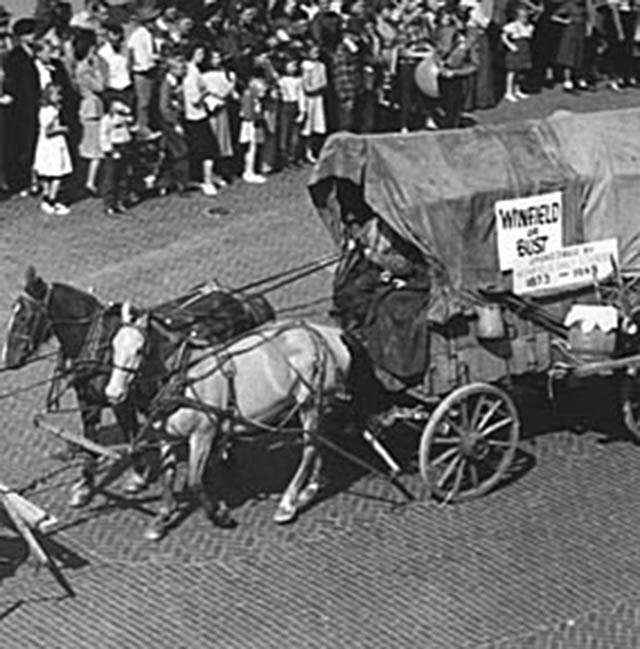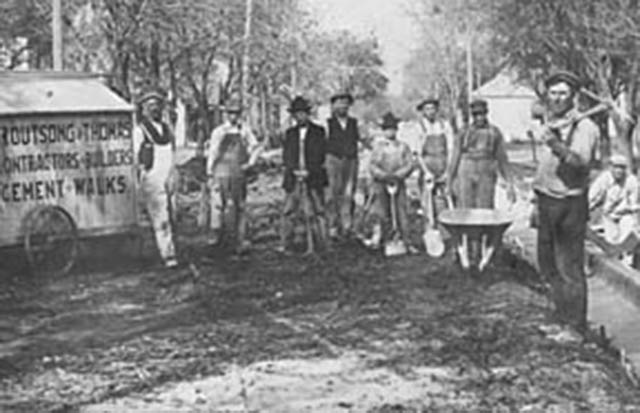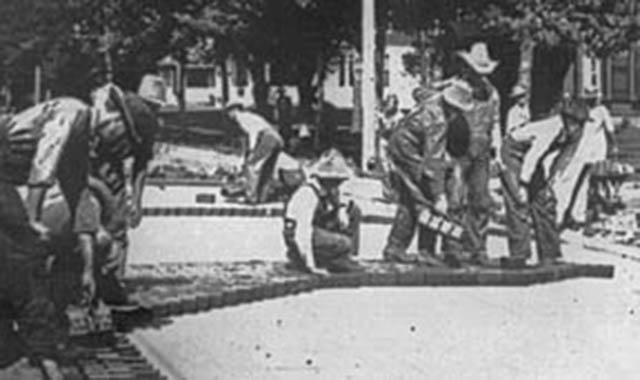








In the beginning it was bricks

WINFIELD OR BUST - That's the sign on this covered wagon during the parade celebrating Winfield's 70th anniversary in 1943. Note the all-brick pavement in this scene at the intersection of Ninth and Main. You're looking at the State Bank before the Main Street addition was built. (Special to the Courier)
Three old photographs from the Cowley County Historical Museum shed some light on the history of Winfield's brick streets and concrete sidewalks.
A major street-paving project was carried out during the first two decades of the 1900s. It is believed that most, if not all, of the bricks came from brickworks in the Cedar Vale area, although Coffeyville and Peru may have supplied some. One reader believes there was a brickworks on the north edge of town in the Timber Creek area, but research so far has not confirmed this.

Barbara Kelley of Winfield says she recalls her grandmother, Lois Valentine, telling about Lois' father, Lon Dobson, hauling wagonloads of brick and helpers to Winfield. At the time, Lon was a ranch hand at the 101 Ranch in north-central Oklahoma, and the story goes that the wagons and helpers were from that ranch. The source of the bricks, and whether they were for streets or buildings, is a mystery. Later, shipments of brick came in by rail.
One of the major brick-street contractors was the Charles L. Besler Contracting Co. of Winfield. A major contractor for the concrete sidewalks and curbing was Routsong & Thomas, also of Winfield. And reader Mary Miller points out the inscription of F.M. Benson Bldr on old sidewalk slabs in the north Manning Street area.
Loren Wade says his father, Joe Wade, then 25 years of age, was a crew foreman for one of the paving contractors. And Loren recalls being told that his uncle, Roy Wade, also a bricklayer, walked off the job at age 17 on the day Loren was born, July 25, 1912. Roy worked for his father but Loren doesn't know the reason for his quitting.
Russ Tomevi, Winfield's director of public works, says the paving process involved first excavating and leveling the soil bed, then pouring four to five inches of lean concrete. After that had hardened, just enough sand was spread to facilitate leveling the bricks. Once they were laid, sand was lightly spread over the top and brushed into the seams. The bricks were delivered to the site by wagons and were piled sytematically along each street so that just enough bricks would be available close by in each block as the work progressed.
Tomevi said that while the city has no official policy regarding preservation of the brick streets, nowadays an effort is made to replace the brick pavement whenever possible. There was a time, he said, that whenever a street had to be opened in a construction project the resulting hole in the pavement was filled with concrete.
It was explained that while the old bricks were designed to withstand the traffic of the time, the vehicles of today are considerably heavier. Tomevi said brick pavers in use today are much stronger. They're really concrete, but they look just like bricks and they can be shaded. As an example, he cited the brick paving at the entrance to Island Park.
In the early days when streets were unpaved, rainy days turned streets into mud pits that took days to dry. There were no gutters or catchbasins for draining, so the water stayed in the streets. And summer temperatures baked them to dust.

Potholes, which normally occur within a few years of putting down asphalt, are unheard of on brick streets because the spacing between the bricks allows them to move as the weather changes. Brick streets do warp over time into a veritable topography of hills and valleys. However, don't blame the brick for this effect. Instead, look to the concrete bed underneath, which cracks and wears out over time just as concrete roads do.
A thank-you - We much appreciate the loan of the old photos for this column by Frankie Cullison and the Cowley County Historical Museum as well as the many recollections offered by readers. The museum would welcome donations of more memorabilia for its brick streets file.
The good old days? - As downtown is being spruced up, we're reminded that a similar effort was made 114 years ago. Frankie Cullison unearthed a report of a city council meeting of Feb. 22, 1886, at which the public health committee was instructed to launch a cleanup campaign of cellars, pigpens and garbage "on account of the unsanitary conditions in the city." Main Street's Lois Loucks may have some problems today, but fortunately pigpens isn't one of them.
Slipping and sliding - Doris Richardson offers another insight about our brick streets. She recalls that "one winter evening in the mid-1960s, a very heavy coating of ice fell while we were at a Presbyterian Church meeting. We then lived at 720 E. 12th but chose to return home on 11th. There was absolutely no traction on the ice, and the street had such a crown our Ford Fairlane could not stay on top.
"To get home, one of us had to walk beside the car's back fender and keep it from sliding into the cars parked at the curb. It didn't take much more than the pressure of one hand to keep the car straight. We arrived home safely."
